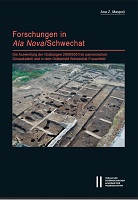Forschungen in Ala Nova/Schwechat
Die Auswertung der Grabungen 2009/2010 im pannonischen Donaukastell und in dem Gräberfeld Schwechat Frauenfeld
Author(s)
Maspoli, Ana Zora
Collection
Austrian Science Fund (FWF); Austrian Science Fund (FWF); AG UniversitätsverlageLanguage
GermanAbstract
Until now, forts and cemeteries at the Pannonian Limes have
rarely been the focus of research, and thus both the interior
construction of the Pannonian fort of Ala Nova and an associated
cemetery outside of it have only been known through isolated and
random discoveries. The analysis of two archaeological
investigations (Bundesdenkmalamt/Archäologie Service
2009/2010) in the fort Ala Nova as well as in the associated
cemetery make it possible for the first time to work out the
Metadaten 3
chronological classification of the construction and (post-)use
phases of the fort and the fort area (1st half of 3rd to late 4th or
early 5th century AD) and the cemetery (3rd century AD) as well
as the burial rites of the biritual cemetery. For the analysis, the
features with their relative chronological sequence and the
artefacts from the area of two military barracks and a section of
the rampart ditch of the fort, as well as from 136 burials, some
pits and a ditch in the cemetery were taken into account. Kastelle und Gräberfelder am pannonischen Limes standen
bisher selten im Fokus der Forschung und so waren sowohl die
Innenbebauung des pannonischen Kastells Ala Nova als auch ein
zugehöriges Gräberfeld ausserhalb davon bisher erst über
Einzel- und Zufallsfunde bekannt. Die Bearbeitung und
Auswertung zweier archäologischer Untersuchungen
(Bundesdenkmalamt/Archäologie Service 2009/2010) im Kastell
Ala Nova sowie in dem zugehörigen Gräberfeld ermöglichen nun
erstmals die Ausarbeitung der chronologischen Einordnung der
Bau- und (Nach)nutzungsphasen des Kastells bzw. auf dem
Kastellareal (1. Hälfte 3. bis spätes 4. bzw. frühes 5. Jh. n. Chr.)
und des Gräberfeldes (3. Jh. n. Chr.) sowie der Bestattungs- und
Beigabensitten des birituellen Gräberfeldes. Für die Auswertung
wurden die Befunde mit ihrer relativchronologischen Abfolge und
das Fundmaterial aus dem Bereich zweier Mannschaftsbaracken
und eines Abschnittes des Wallgrabens des Kastells, sowie aus
136 Bestattungen, einigen Gruben und einem Graben im
Gräberfeld herangezogen.


 Download
Download